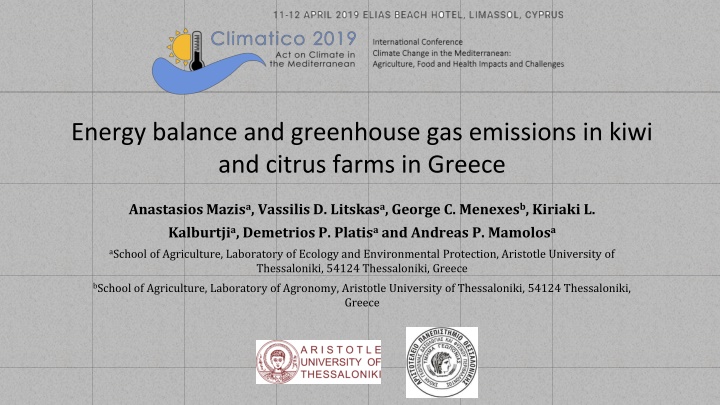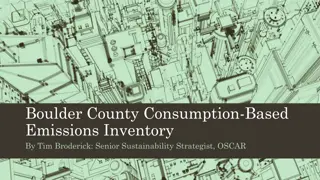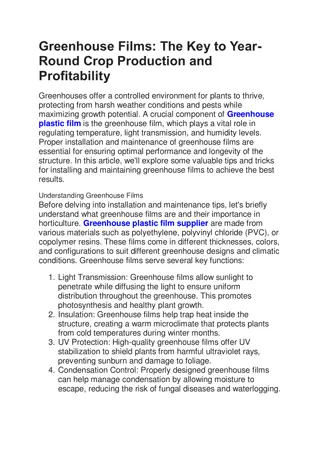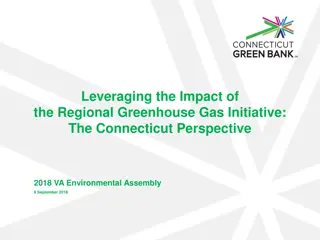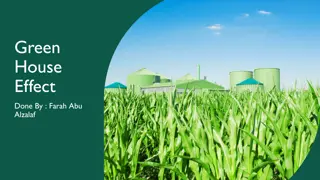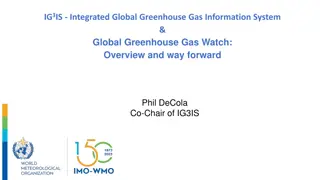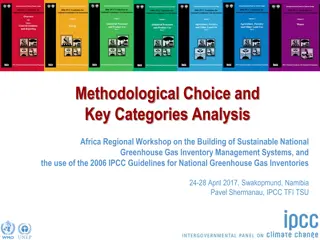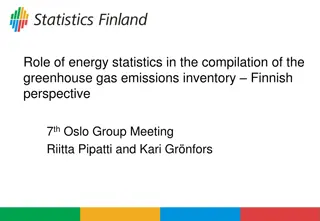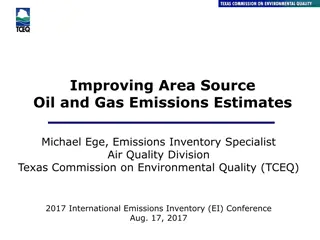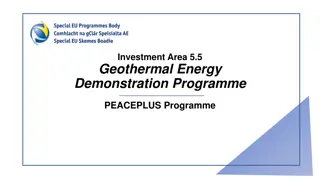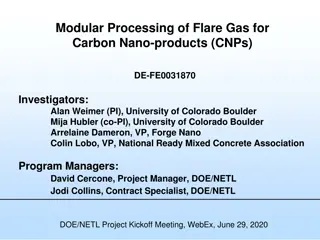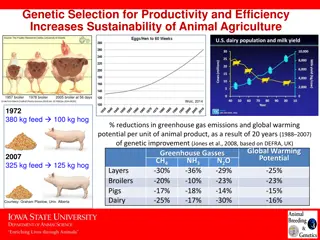Energy Balance and Greenhouse Gas Emissions in Agriculture
This study explores the energy balance and greenhouse gas emissions in kiwi and citrus farms in Greece, highlighting the significant impact of agriculture on global energy consumption and climate change. It discusses the distribution of energy consumption in agri-food chains, shares of energy in production stages for various products, and the contribution of agriculture to greenhouse gas emissions. The research emphasizes the need for sustainable practices in agriculture to mitigate climate change effects.
Download Presentation

Please find below an Image/Link to download the presentation.
The content on the website is provided AS IS for your information and personal use only. It may not be sold, licensed, or shared on other websites without obtaining consent from the author.If you encounter any issues during the download, it is possible that the publisher has removed the file from their server.
You are allowed to download the files provided on this website for personal or commercial use, subject to the condition that they are used lawfully. All files are the property of their respective owners.
The content on the website is provided AS IS for your information and personal use only. It may not be sold, licensed, or shared on other websites without obtaining consent from the author.
E N D
Presentation Transcript
Energy balance and greenhouse gas emissions in kiwi and citrus farms in Greece Anastasios Mazisa, Vassilis D. Litskasa, George C. Menexesb, Kiriaki L. Kalburtjia, Demetrios P. Platisaand Andreas P. Mamolosa aSchool of Agriculture, Laboratory of Ecology and Environmental Protection, Aristotle University of Thessaloniki, 54124 Thessaloniki, Greece bSchool of Agriculture, Laboratory of Agronomy, Aristotle University of Thessaloniki, 54124 Thessaloniki, Greece
Energy consumption in agri-food chain Globally, the agri-food chain: - consumes 30 % of the world s available energy - more than 70 % consumed beyond the farm gate (after harvest). More than 1/3 of the food we produce is lost or wasted, and with it about 38 % of the energy consumed in the agri-food chain. Source: FAO - the role of energy in food security and climate (http://www.fao.org/3/an913e/an913e01.pdf)
Data from the EU The energy for food production (field to fork): 26 % of the EU s energy consumption. (JRC, 2015) http://publications.jrc.ec.europa.eu/repository/bitstream/JRC96121/ldna27247enn.pdf
Shares of energy in the production stages is very different in different products: - For meat and dairy the agriculture step is overwhelming, - packaging plays an important role in the bottled products (milk, oil, beer and mineral water). In determine to a large extent the amount of energy inputs used in crops. the field, farming practices Shares of energy embedded in a kilogram of each of the 17 products along the different production steps (JRC, 2015) http://publications.jrc.ec.europa.eu/repository/bitstream/JRC96121/ ldna27247enn.pdf
: Greenhouse Gas Emissions - Carbon dioxide (CO2) Fossil fuel, deforestation, land clearing for agriculture, and degradation of soils. Most N2O is produced after croplands are fertilized, when soil microbes convert some of the applied nitrogen from fertilizer and manure into N2O. Nitrous oxide (N2O) GHGs Burning biomass to prepare fields Ruminant livestock digest their food through enteric fermentation, which produces methane. Methane (CH4) Rice grown in paddies, where bacteria break down biomass submerged in the fields.
: Contribution of Agriculture to Global GHG Emissions Agriculture, which is a significant contributor to global GHG emissions, must do its share to minimize climate change
Life Cycle Assessment (LCA) life cycle assessment (LCA) is a tool for analyzing the environmental impacts and resources used product's life, from extraction to production, and extending through product use and disposal. The goal: compare the full range of environmental effects assignable to products and services by quantifying all inputs and outputs of material flows, and then assessing how these material flows impact the environment throughout raw a materials LCA can be used to compare alternative products, processes compare alternative life cycles for a certain product or service; or identify the parts of a life cycle where the greatest improvements can be made (optimization process). or services; Energy and Greenhouse Gases
Aim of the study The aim of this study was to determine the energy balance and GHG emissions in Kiwi and Citrus orchards, located in the area of Arta, Greece.
Study area The farms were located near the city of Arta, Greece 10 Citrus farms and 16 Kiwi farms
: Energy inputs-outputs Human labor, machinery, electricity, diesel fuel, fertilizers, biocides amounts. Converted into energy values using the most recent energy coefficients taken from the literature. Inputs Unit of measurement: MJ ha-1 (or MJ kg-1) Product yield. Converted into energy unit using their corresponding coefficients from the literature or experimentally (Bomb Calorimeter). Outputs
: Carbon Footprint Using the IPCC guidelines to convert inputs to emissions. Unit of measurement: CO2eq Amount of produced CO2eq: multiplying the input used rate (diesel fuel, chemical fertilizer, biocide, farmyard manure and electricity) by their corresponding emission coefficient from the literature. Cultivation process Carbon Footprint kg CO2eq Agricultural product Kg Indicator =
Citrus energy balance Citrus energy inputs : 52217 (s.d. 4902) MJ/ha. Energy intensity (Inputs/kg product) = 2.32 (s.d. 0.20) MJ/kg Energy efficiency (outputs/inputs) = 0.83 (s.d. 0.07) Citrus Energy inputs Human Labour 2% Irrigation 16% Fungicides 1% Herbicides 0% Fuel 38% Pesticides 0% Fertilizers 32% Machinery 11%
Kiwi energy balance Kiwi energy inputs : 48774 (s.d. 5010) MJ/ha. Energy intensity (Inputs/kg product) = 2.39 (s.d. 0.48) MJ/kg Energy efficiency (outputs/inputs) = 0.83 (s.d. 0.19) Kiwi Energy inputs Human Labour 2% Irrigation 21% Fungicides 1% Fuel 33% Herbicides 0% Pesticides 0% Machinery 13% Fertilizers 30%
Energy intensity (MJ/kg) In studies on olive trees, vines and orchards in the Mediterranean, the reported values for EI range from 0.99 for indigenous vine varieties to 59 MJ/kg for intensively managed olive groves (Genitsariotis et al., 2000; Litskas et al., 2011, 2013; Michos et al., 2018). Kiwi and Citrus 2.39 and 2.32 MJ/ha.
GHG emissions 0.100 2000 CO2-eq (kg/kg prod.) Citrus Kiwi Citrus Kiwi 0.080 CO2-eq (kg/ha) 1500 0.060 1000 1480 0.040 1077 500 0.020 0.029 0.023 0.000 0
Conclusions Similar energy inputs, intensity and efficiency in Citrus and Kiwi farms located in Arta, Greece. The factors determining the energy inputs are: 1) irrigation, 2) fuel, 3) machinery, 4) fertilizers. GHG emissions are considered low, relevant to values from the literature, but fuel and N2O emissions from soil were only accounted at this point.
